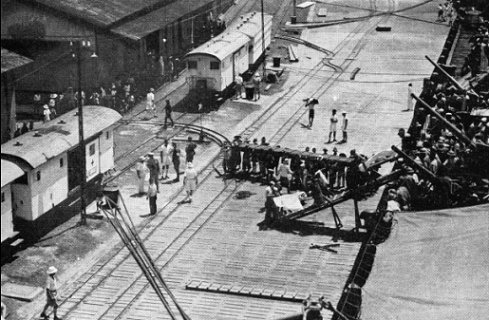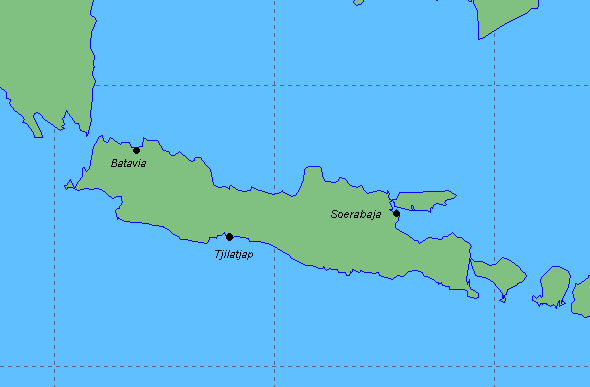Introduction
In the few years before the second world war, the Dutch finally began clearing up the long
period of inactivity, especially when it came to the defences of the Netherlands East
Indies. The defence of this colony was based on the fact that Java would be the centre of
it, comparable to Singapore in Malaya. Taking the weakness of the Navy, Army and Airforce
in consideration, it was not unthinkable that the waters north of Java would be controlled
by an invader. Now a fundamental problem comes to light. The only two ports capable
of dealing with the immense amounts of supplies and warmaterials, Batavia (Tandjong Priok) and Soerabaja,
were located on the northern shore. In case of an enemy controlling the Javasea, the defenders of Java could not be supplied with the materials vital for their survival. This
problem was recognized in 1940 when a start was made with the improvement of the defences
in the archipelago. One of the measures taken was that Tjilatjap, the only port of size on the
southern coast was to be made suitable of handling a large amount of goods.
Tjilatjap
The port itself was the only one of importance on the southern coast, and therefore very
vulnerable. But before it would be capable of handling this task, there was a lot
of work to be done. The port itself was in fact not a good "natural" harbor. The entrance
was very narrow and tortuous, with shallows, rocks and currents. The port was capable of
handling ships with a maximum draught of a little less than 30 feet. There were only four
piers suitable for larger ships, and only one usable for tankers (owned by BPM). The defence against ships consisted of a fortress housing three 75 mm and
two 150 mm guns, protection against aircraft was virtually non-existent.
 |
Wounded of the USS Marblehead are brought ashore after the encounter with Japanese aircraft in early February |
Preparations
After May 1940, the civil and military organizations had the impossible task of making the
NEI ready for war, but the task was even more difficult because the motherland had become
unreachable. The NEI, not having an industry of any importance itself, was forced to use
whatever was available. Nevertheless, most alterations were completed before the Japanese
attack on Pearl Harbor in December 1941, mostly as a result of hard work by the Staatsmobilisatie-raad. This board was erected in 1940 to combine the efforts of the military and
civil organizations, in order to improve the defences. And it did quite a good job during
the early war years, as it managed to successfully overcome countless problems.
The alterations of the port itself included both strenghtening the defences as making the
port suitable for handling about 250.000 tons of cargo each month. The latter was in fact
the most difficult and costly job, as it included deepening the entrance by one metre and
the addition of new facilities. Navigation lights were placed along the entrance, a dozen mooring-
buoys were laid in the port near the island Noesa Kambang and new piers with electric cranes were built for unloading the ships. These alterations ofcourse meant that the population increased considerably, and large numbers of dockworkers (and their families) had be
accommodated. For them, new barracks, hospitals and cantines were built. Besides them,
new pilots to guide the ships through the entrance were found, specially trained and accommodated.
| The three main ports on Java island. |
 |
But, in spite of the enormous efforts put into the task, there were still some evident
shortcomings. For example, the new piers were too short to handle all the ships at once,
so the cargo had to be brought ashore by lighters ( 100 of which were routed to Tjilatjap
in 1941 ), and the mooringbuoys used to keep the ships in place were too lightly built.
Their mooringwires were expected to snap easily, causing large ships to go adrift.
But the main problems was the fact that the combined organizations didn't get the time
to increase the transportcapacity of the railway from and to Tjilatjap. The Staats-
mobilisatieraad estimated that about 8000 tons of goods were to be delivered inland,
all of which had to be transported over a single railway. This created the danger of
empty wagons going to Tjilatjap blocking the way for loaded wagons going inland, which
happened quite frequently.
The war
Despite all these disadvantages, Tjilatjap appeared to have functioned properly, supplying
the defenders of Java with equipment and stores even after Batavia and Sourabaja had become unreachable to anything except submarines. Last moment improvements were the arrival
of an 8000-ton drydock of the Drydock Co. Tandjong Priok in mid December, and the arrival
of the Royal Netherlands Navy repair ship Barentsz in early January 1942.
Unfortunately, the port itself was only lightly protected against attacks from the sea and
air, and it is surprising that the first air attack occured as late as March 5 1942, only a few
days before the surrender of the Allied forces on Java. This was in fact not an indication
the Japanese underestimated the value of Tjilatjap. They judged the fleettrain from and
towards this port valuable enough to deploy a large squadron, the bulk of which were six
carriers and four battleships, south of Java. By this time ( in late February ), the situation in the NEI
had worsened dramatically, and preparations were made to evacuate most personnel. When
the evacuation ships started leaving the port, most of them met their doom. Torpedoed or
shelled, and packed with evacuees, many went down with heavy loss of life. The exact toll
is unknown, but one can say with certainty that many hundreds of people lost their lives
in this final stage... |
![]()
![]()
![]()
![]()